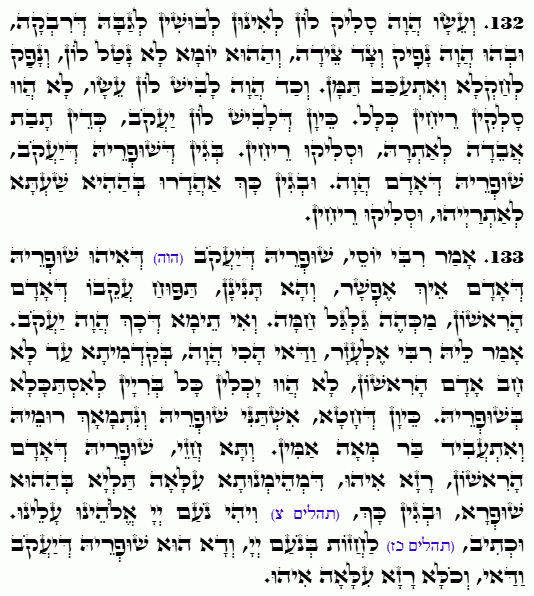Daily Zohar # 4715 – Toldot – Pleasantness of beauty
Daily Zohar 4715

Hebrew translation:
133. אָמַר רַבִּי יוֹסֵי, יָפְיוֹ שֶׁל יַעֲקֹב [הָיָה] שֶׁהוּא יָפְיוֹ שֶׁל אָדָם אֵיךְ אֶפְשָׁר? וַהֲרֵי שָׁנִינוּ, תַּפּוּחַ עֲקֵבוֹ שֶׁל אָדָם הָרִאשׁוֹן מַכְהֶה גַּלְגַּל חַמָּה, וְאִם תֹּאמַר שֶׁכָּךְ הָיָה יַעֲקֹב? אָמַר לוֹ רַבִּי אֶלְעָזָר, וַדַּאי שֶׁכָּךְ הָיָה. בָּרִאשׁוֹנָה טֶרֶם חָטָא אָדָם הָרִאשׁוֹן, לֹא הָיוּ יְכוֹלִים כָּל הַבְּרִיּוֹת לְהִסְתַּכֵּל בְּיָפְיוֹ. כֵּיוָן שֶׁחָטָא, הִשְׁתַּנָּה יָפְיוֹ וְרוּמוֹ הֻנְמַךְ, וְנַעֲשָׂה בֶּן מֵאָה אַמּוֹת. וּבֹא וּרְאֵה, יָפְיוֹ שֶׁל אָדָם הָרִאשׁוֹן הוּא סוֹד, שֶׁהָאֱמוּנָה הָעֶלְיוֹנָה תְּלוּיָה בַּיֹּפִי הַהוּא, וּמִשּׁוּם כָּךְ (תהלים צ) וִיהִי נֹעַם ה’ אֱלֹהֵינוּ עָלֵינוּ, וְכָתוּב (שם כז) לַחֲזוֹת בְּנֹעַם ה’. וְזֶהוּ וַדַּאי יָפְיוֹ שֶׁל יַעֲקֹב, וְהַכֹּל הוּא סוֹד עֶלְיוֹן.
.
Zohar Toldot
Continued from previous DZ
#132
Esau kept those garments hidden with Rebecca, and he would wear them when he went out to hunt. On the day Isaac sent him to receive the blessings, Esau did not take those garments and went out to the field without them. Therefore, he was delayed. The explanation is that since Esau was not wearing the garments, the animals did not gather around him as they usually would, and he had to chase after them. Thus, he was delayed, allowing Jacob time to take the blessings.
When Esau wore the garments, they did not emit any fragrance. However, when Jacob wore them, it was as if the lost had been restored to its rightful place, as the garments returned to the state of Adam. Jacob’s appearance resembled the beauty of Adam, and thus, when Jacob wore them, the garments gave off a pleasing fragrance.
#133
Rabbi Yossi said: “You claim that Jacob’s beauty was the same as the beauty of Adam. How is this possible? After all, we have learned that the radiance of Adam’s heel dimmed the sun. Can you say that Jacob was of such beauty?”
Rabbi Elazar replied: “Indeed, it was so originally before Adam sinned. At that time, no creature could gaze upon his beauty. However, Adam’s beauty diminished after his sin, his stature was reduced, and he was left with a height of one hundred cubits. Before the sin, his stature extended from the earth to the heavens. Jacob’s beauty matched that of Adam after the sin.
Come and see: The beauty of Adam was connected to the higher faith (אמונה העליונה), which is Binah. His beauty derived from the Light of Binah. Therefore, the verse says, “וִיהִי נֹעַם ה’ אֱלֹהֵינוּ עָלֵינוּ” ‘May the pleasantness (נעם no’am) of YHVH our God be upon us’ (Psalms 90:17), as the Light of Binah is referred to as ‘pleasantness’. It is also written, “לַחֲזוֹת בְּנֹעַם ה'” ‘to gaze upon the pleasantness of YHVH’ (Psalms 27:4). This is certainly the beauty of Jacob, who, like Adam, merited the Light of Binah. All of this pertains to a sublime and exalted secret.
Notes:
This teaching highlights Jacob’s spiritual elevation. Like Adam, Jacob was a conduit for the Light of Binah. Jacob’s beauty represents not merely physical appearance but a spiritual radiance reflecting his alignment with a higher level of faith (אמונה העליונה).
The lesson reminds us of the transformative potential of reconnecting with the Light, even after a spiritual fall. Like Jacob, we are encouraged to seek alignment with higher understanding and to reflect the “נֹעַם יהוה” “pleasantness of YHVH” in our lives, fostering spiritual elevation and harmony.
}||{

 Previous: Toldot
Previous: Toldot

